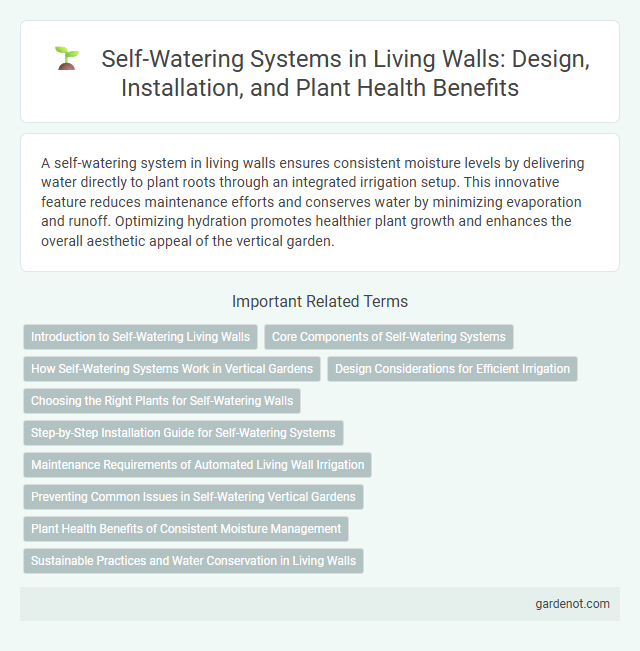A self-watering system in living walls ensures consistent moisture levels by delivering water directly to plant roots through an integrated irrigation setup. This innovative feature reduces maintenance efforts and conserves water by minimizing evaporation and runoff. Optimizing hydration promotes healthier plant growth and enhances the overall aesthetic appeal of the vertical garden.
Introduction to Self-Watering Living Walls
Self-watering living walls utilize integrated irrigation technologies that provide consistent moisture to plants, enhancing growth and reducing maintenance. These systems typically feature drip irrigation or capillary matting combined with water reservoirs, ensuring efficient water usage and minimizing evaporation. Optimized for both indoor and outdoor applications, self-watering walls promote sustainable urban greening by maintaining plant health with minimal manual intervention.
Core Components of Self-Watering Systems
Self-watering systems for living walls rely on key components such as water reservoirs, capillary mats, and wicking mechanisms that ensure consistent moisture delivery to plant roots. Automated irrigation timers and moisture sensors optimize water usage by adjusting flow based on real-time soil conditions. These core elements work together to promote healthy plant growth, reduce maintenance, and conserve water efficiently.
How Self-Watering Systems Work in Vertical Gardens
Self-watering systems in vertical gardens use a combination of capillary action and gravity to deliver water evenly across plant roots, minimizing evaporation and runoff. A reservoir stores water that is gradually absorbed through wicks or porous materials embedded in the soil or growth medium. This efficient method maintains optimal moisture levels, promoting healthy plant growth while reducing the frequency of manual watering.
Design Considerations for Efficient Irrigation
Efficient irrigation in living walls requires a self-watering system designed to optimize water distribution and minimize waste. Key considerations include selecting drip emitters with adjustable flow rates, integrating moisture sensors to monitor soil hydration, and ensuring proper drainage to prevent waterlogging. Incorporating automated timers and durable tubing materials enhances system reliability and longevity while promoting sustainable water usage.
Choosing the Right Plants for Self-Watering Walls
Choosing the right plants for self-watering living walls involves selecting species with moderate water needs and tolerance for consistent moisture levels, such as ferns, succulents, and pothos. These plants thrive in the controlled hydration environment provided by the self-watering system, optimizing growth while minimizing maintenance. Integrating drought-resistant varieties enhances the efficiency and sustainability of the vertical garden by preventing overwatering and root rot.
Step-by-Step Installation Guide for Self-Watering Systems
Step-by-step installation of a self-watering system for living walls begins with selecting a compatible water reservoir and ensuring proper placement at the base of the structure. Next, connect and secure the drip irrigation lines to deliver water evenly across all plant pockets, followed by installing a water delivery tube into each pocket for automatic hydration. Finally, test the system for leaks, adjust water flow settings, and program timers or sensors to maintain consistent moisture levels and promote optimal plant health.
Maintenance Requirements of Automated Living Wall Irrigation
Automated living wall irrigation systems with self-watering technology significantly reduce maintenance by ensuring consistent hydration through sensors and timed water delivery. These systems minimize water waste while preventing overwatering, lowering the risk of plant stress and root rot. Routine maintenance primarily involves periodic inspection of the irrigation components and cleaning filters to sustain optimal functionality.
Preventing Common Issues in Self-Watering Vertical Gardens
A self-watering system in living walls prevents common issues such as overwatering, root rot, and uneven moisture distribution by maintaining consistent hydration through automated drip irrigation or capillary matting. Proper drainage and using water-retentive yet breathable substrates help avoid waterlogging and promote healthy root oxygenation. Regular maintenance of water reservoirs and monitoring moisture sensors ensure optimal plant health and longevity in vertical gardens.
Plant Health Benefits of Consistent Moisture Management
A self-watering system in living walls ensures consistent moisture levels, promoting optimal plant hydration and reducing stress caused by irregular watering. This steady water supply supports root development, leading to healthier foliage and improved plant resilience. Consistent moisture management also minimizes the risk of diseases linked to overwatering or drought, enhancing overall plant vitality and longevity.
Sustainable Practices and Water Conservation in Living Walls
A self-watering system in living walls integrates sustainable practices by reducing water waste through automated irrigation that targets plant roots directly. This method conserves water by recycling runoff and minimizing evaporation, which significantly lowers overall water consumption in urban greenery projects. Utilizing hydroponic technology and moisture sensors ensures optimal hydration, promoting healthier plant growth while supporting eco-friendly landscaping initiatives.
Self-watering system Infographic

 gardenot.com
gardenot.com